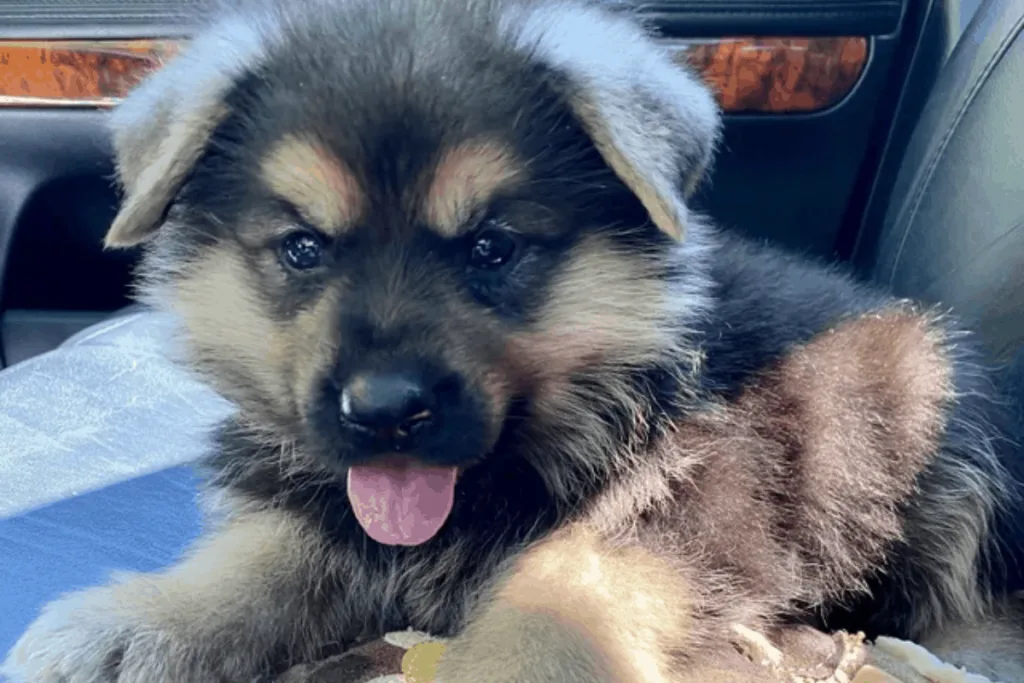
Dwarf German Shepherds are making their way into the public eye. With their tiny stature and unique appearance, it’s no wonder so many people are looking into this mysterious pup. So what is a Dwarf German Shepherd, why are they so much smaller than other Shepherds?
Dwarfism in German Shepherds is a genetic disorder most often caused by a lack of growth hormones produced by the pituitary gland, and can result in a shortened lifespan. While there is no cure for canine dwarfism, it can be successfully treated with progesterone and thyroid medications.
In this article we’ll dive into the details of canine dwarfism, and help you understand why the intentional breeding of this pup is unethical.
Click Here to Jump to a Section
What Is A Genetic Defect?
Before we discuss the details of dwarfism in German Shepherds, it’s important to understand what a genetic defect is in the first place. A genetic defect occurs because of a change in the normal DNA sequence, resulting in some type of chronic condition or disease.
Some genetic disorders are inherited from parents and can be seen at time of birth, while others can develop through gene mutation later in life.
No matter the cause of a genetic defect, they most often result in serious impact to overall life and health.
What is Canine Dwarfism?
Canine dwarfism, or pituitary dwarfism, is an inherited disorder that impacts the growth of the dog affected. While this genetic defect can happen in any dog breed, is it most common in German Shepherds and certain breeds of Wolfhounds.
Canine dwarfism impairs the function of the pituitary gland, and causes the gland to produce a decreased and insufficient amount of growth hormones.
Since these hormones play such an important role in regulating growth and other vital functions, this can result in canine dwarfism and other medical conditions.
Both parents have to carry the defective gene for a German Shepherd puppy to have the disorder, but it is becoming more and more common as time goes on.
About 20% of German Shepherds are said to carry this gene, meaning dwarfism in German Shepherds may be on the rise.
What Causes Dwarfism In German Shepherds?
While dwarfism in German Shepherds is generally caused by a lack of growth hormones produced by the pituitary gland, there are a few other possible causes as well.
To help you understand all the possible factors behind this condition, let’s cover a few.
Dwarfism in German Shepherds can be caused by:
- Decreased amount of growth hormones from the pituitary gland
- Brain tumors or cysts
- Other genetic conditions impacting growth such as skeletal dwarfism
- Chronic infections
Signs Of Dwarfism In German Shepherds
So how do you know if a German Shepherd has canine dwarfism? While every pup will vary, there are a few signs to look for. Some of the signs of canine dwarfism are changes in the dog’s physical appearance, while others are changes to their overall health.
Physical signs of dwarfism in German Shepherds:
- Small stature, often obvious by 12 weeks of age
- Retaining their puppy coat for much longer periods
- Hair loss when they do finally lose their puppy coat
- Slow growth rate, or never reaching full adult size
Medical signs of dwarfism in German Shepherds:
- Undescended or small testes in male Shepherds
- Absent or irregular heat cycles in female Shepherds
- Delay in dental growth
- Skin infections
- Fur loss, or alopecia
- Underdeveloped kidneys, often causing renal disease
- Cardiac problems
- Breathing difficulties
- Hypothyroidism
- Abnormal distribution of cervical vertebrae
Complications Of Dwarfism In German Shepherds
Having a condition that impacts hormones that are responsible for so many vital functions can result in a slew of medical complications.
Canine dwarfism not only causes stunted growth in German Shepherds, but a host of other troubling complications as well.
Some of the most common complications of dwarfism in German Shepherds include:
- Chronic skin infections that are slow to heal
- Kidney disease and ultimately kidney failure due to underdeveloped kidneys
- Liver disease and ultimately liver failure due to an underdeveloped liver
- Secondary hypothyroidism that needs to be managed with daily medication
- Possible breathing difficulties if their ribs do not develop properly
- Possible back pain and injury due to abnormal distribution of the cervical vertebra
- Overall shortened lifespan due to a strain on so many body processes
Related: How Long Do German Shepherds Live? A Detailed Guide
Preventing Dwarfism In German Shepherds

When preventing dwarfism in German Shepherds, it all comes down to the breeding. Since there is no way to get rid of the genetic defect once the dog is born, the only true way to prevent the condition is by testing both parents for the gene before they breed.
If you are bringing a new German Shepherd into your line of breeding, it is always best to perform genetic testing that searches for any genetic mutations or disorders.
Since about 20% of German Shepherds are found to have the genetic mutation for dwarfism, the possibility is real. It’s important to make sure that you are not introducing this issue to your future puppies.
Genetic testing is not a mandatory part of breeding, meaning many breeders are unaware of potential genetic mutations in their Shepherds.
Most dog owners are not aware that their German Shepherds have canine dwarfism until they reach 3-4 months of age, meaning their diagnosis may not ever make it back to their original breeders.
If you are concerned about the possibility of purchasing a puppy with canine dwarfism, the only way to prevent this is by choosing a breeder that performs genetic testing.
While these puppies will often be more expensive, it is a useful way to ensure that you are buying a healthy puppy.
Can You Treat Dwarfism In German Shepherds?
There is no way to cure dwarfism in German Shepherds, but there is a way to manage it and offer a better quality of life.
These management options help to make up for the lack of appropriate hormones in the affected pup, and combat any medical conditions it may cause.
Some of the treatment options for canine dwarfism include:
- Progesterone treatments that stimulate the production of growth hormones
- Thyroid medication that offers artificial thyroid hormones to supplement where they are lacking
The only way to offer an effective and safe management plan for canine dwarfism is through a close relationship with your regular vet.
This will be a lifelong issue that cannot be cured, meaning they will need a long-term and individually tailored treatment plan.
Why Do Some Breeders Sell Dwarf German Shepherds?
People love the idea of a miniature version of their favorite breed. Because of this, some breeders do what they can to take advantage of this desire.
By changing the title to “Mini German Shepherds”, some breeders are able to sell puppies that are not in ideal health.
Though some breeders may sell dwarf German Shepherds knowingly under a different title, some may not be aware that their puppies have been exposed to this genetic defect.
As we discussed above, not all breeders perform DNA testing on their adults.
Related: How to Choose the Right German Shepherd Puppy From a Litter
This is why it’s so important to be aware of this condition in German Shepherds, and to choose an ethical breeder that has performed genetic testing at some point.
Are Mini German Shepherd’s Real?
No, there is no such thing as a Mini German Shepherd. The only way for a German Shepherd to have a small stature is by:
- breeding Shepherds with a smaller breed
- breeding Shepherds with canine dwarfism
- breeding Shepherds that are significantly smaller than others
No matter which scenario is the case, each option comes with its own line of potential health risks.
Any time you are modifying a breed to be smaller in nature, you are automatically introducing them to a slew of medical complications that come along with that reality.
German Shepherds are bred to be large and majestic, never miniature and dainty. If you ever see the title of “Mini German Shepherd”, it’s best to run the other way.
Should You Get A Mini Shepherd?
In our opinion, you should never purchase a Mini Shepherd. As we mentioned above, a Mini German Shepherd is usually a product of poor breeding methods or breed mixtures.
Mini Shepherds can come with multiple medical complications, meaning they may have an unhealthy future ahead of them.
If you are looking for a German Shepherd to welcome into your family, it’s best to choose an ethical and reputable breeder. If you want a smaller pup, we recommend a breed other than a German Shepherd.
Take a look at the video below, as it highlights some of the health complications that a Mini Shepherd can face:
What is the Lifespan of a Dwarf German Shepherd?
Because canine dwarfism involves the damage to the pituitary gland which causes it to not function properly, a dog with untreated canine dwarfism has a shortened life span.
Dwarfism can also cause complications with many body systems, thus putting extra stress on so many different parts of a dog’s health, contributing to a shortened lifespan.
A dog that is never treated for their dwarfism may only reach 4-5 years of age, while dogs with long-term management can have relatively normal lifespans.
A Shepherd with dwarfism has the best chance at a long and healthy life if they receive proper management, making it extremely important to look for any possible signs of this condition.
Final Thoughts
Though the thought of a tiny German Shepherd sounds adorable, the reality of the situation is not as cute.
Be sure to review the information that we discussed above, and you can be better informed on this troubling canine disease.
Most importantly, you can do your part by thoroughly inquiring into a puppy’s history before getting one.
Make sure that you choose an ethical breeder that performs genetic testing on their dogs to give you the best chance of avoiding this disorder in the first place.
